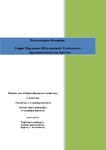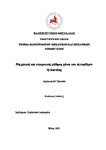| dc.creator | Nikolakaki, M. | en |
| dc.creator | Paraskeva, F. | en |
| dc.date.accessioned | 2015-11-23T10:41:08Z | |
| dc.date.available | 2015-11-23T10:41:08Z | |
| dc.date.issued | 2005 | |
| dc.identifier.issn | 17900832 | |
| dc.identifier.uri | http://hdl.handle.net/11615/31382 | |
| dc.description.abstract | The principle and dominant model of integrating e-learning in traditional teaching in the Anglophone academic world is 'blended learning'. Blended learning also is used to describe learning that mixes various event-based activities, including face-to-face classrooms, live e-learning, and self-paced learning. Blended learning's role is to go beyond online course delivery and actually transform the educational experience. To that end, including educational technology that supports a full range of teaching and learning styles and optimises intellectual and technical resources along with traditional pedagogic forms in University teaching appears to become a necessity in a technological ever-changing world. | en |
| dc.source.uri | http://www.scopus.com/inward/record.url?eid=2-s2.0-33645226286&partnerID=40&md5=d609060328ebfa41924d3b38e96d0787 | |
| dc.subject | Blended learning University teaching | en |
| dc.subject | e-learning | en |
| dc.subject | ICT teaching | en |
| dc.subject | Pedagogy | en |
| dc.subject | Computer aided instruction | en |
| dc.subject | Information dissemination | en |
| dc.subject | Teaching | en |
| dc.subject | Technical presentations | en |
| dc.subject | Blending e-learning technologies | en |
| dc.subject | Face-to-face classrooms | en |
| dc.subject | Information and communications technology (ICT) teaching | en |
| dc.subject | Self-paced learning | en |
| dc.subject | Information technology | en |
| dc.title | Blending e-learning technologies and practices in University Pedagogy: Between theory and praxis | en |
| dc.type | journalArticle | en |



